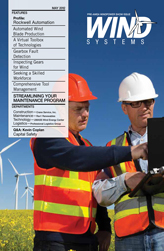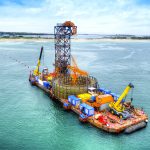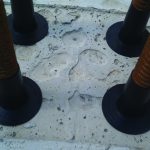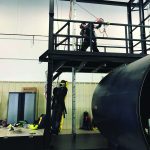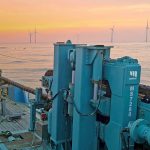In past months we have learned about the maintenance process, rigging techniques, and the different crane types relative to the wind industry. This month we are going to take a look into how the wind speeds change at various heights. The wind speed changes can help reduce wear and tear on the wind components in the air, but it can make hoisting rotors down difficult.
 As we know, wind speed increases as we move higher above the ground.For towers below 100 meters in height we can model the change in wind speed logarithmically and constant speed past 100 meters, meaning the wind speed has a great increase as you leave ground level but the slope decreases and almost becomes flat as you approach your 100 meter mark. From 0 to 20 meters the wind speed can change from 0 m/s to 14 m/s, while the change in wind speeds from 35 meters to 100 meters is roughly 2-3 m/s. If we apply this thought to a real world tower we notice something interesting. If we have an 80 meter tower with a 90 meter diameter blade, we can assume that the blade height will vary from 125 meters to 35 meters, 45 meters above the hub height, and 45 meters below the hub height. This puts the blade right at the 35 meter mark to past our 100 meter mark. With that being said, we will only see a wind speed change of about 3 m/s. This can help reduce the wear and tear of gearboxes, blades, and yaw drives. Now, if we push our towers past the 100 meter mark, then the wind speed can be seen as constant and thus further lowering stresses on the blades.
As we know, wind speed increases as we move higher above the ground.For towers below 100 meters in height we can model the change in wind speed logarithmically and constant speed past 100 meters, meaning the wind speed has a great increase as you leave ground level but the slope decreases and almost becomes flat as you approach your 100 meter mark. From 0 to 20 meters the wind speed can change from 0 m/s to 14 m/s, while the change in wind speeds from 35 meters to 100 meters is roughly 2-3 m/s. If we apply this thought to a real world tower we notice something interesting. If we have an 80 meter tower with a 90 meter diameter blade, we can assume that the blade height will vary from 125 meters to 35 meters, 45 meters above the hub height, and 45 meters below the hub height. This puts the blade right at the 35 meter mark to past our 100 meter mark. With that being said, we will only see a wind speed change of about 3 m/s. This can help reduce the wear and tear of gearboxes, blades, and yaw drives. Now, if we push our towers past the 100 meter mark, then the wind speed can be seen as constant and thus further lowering stresses on the blades.
This concept also plays a big part in the hoisting industry, as we learned in previous articles that hoisting wind components can be difficult and tend to be harder when you are near the hub versus closer to the ground. Although this is true, we cannot underestimate the difficulty of hoisting wind components near the ground. Like we learned above, from the 0 meter to the 20 meter or the 50 foot mark, we can see wind speeds change from 0 m/s to 14 m/s or 0 mph to 30 mph. This can make tailing operations difficult for an operator and his crew. When we are tailing a rotor, our operators and crew have to be in perfect sync and on the same page. As we are lowering the rotor to the ground, the two “rabbit ears” are experiencing different wind speeds than the lower blade. The effect of this can make the sensation of where the blade is moving feel different to each operator, so proper communication between the operators and crew is crucial for a lift like this. You may see the crew on wind parks using taglines to the rabbit-eared blades that are anchored, this also helps combat any rotation of the rotor. To further remain safe while lowering a rotor, we won’t work in speeds in excess of 9 m/s or 20 mph for our lattice boom cranes and 10 mph for our hydraulic cranes. This helps ensure that we don’t have any issues while we are trying to perform the tandem pick.
When our lattice boom truck cranes or crawler cranes are working in windy conditions, the variation of wind speed at the 35 to 80 meter range can be beneficial in a sense. We now know that the wind speed in this range has a smaller change than the sub 35 meter range. This can actually make the lift more stable because as you are hoisting a gearbox, lid, or nacelle to the ground the wind speed change is very gradual at these heights. This makes the lift smoother, as we aren’t experiencing abrupt changes. A good operator can make these lifts appear easy, but in the cab there has to be high level of focus and dedication.
All of our operators are highly trained, experienced operators, and they are certified as well. Most of our operators have surpassed the 20-year mark working in the industry. This allows for us to be very effective in our industry. Couple this with 3D lift planning software from the amazing folks at A1A software, and there isn’t any wind project that we can’t handle.
















